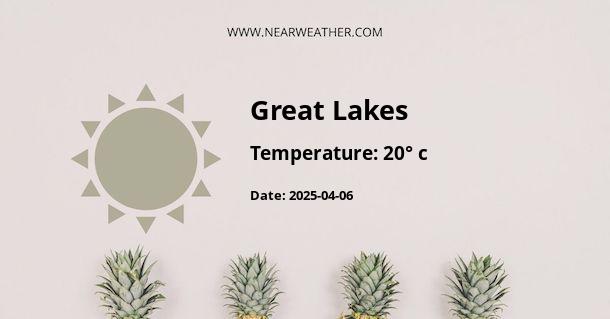Climate and Weather in the Great Lakes, Australia
The Great Lakes region in Australia experiences a diverse and varied climate, influenced by its coastal location and unique topography. Located in the Mid North Coast region of New South Wales, the Great Lakes area is known for its stunning natural beauty, including pristine beaches, lush rainforests, and picturesque lakes. Understanding the climate and weather patterns of this region is essential for residents, tourists, and anyone looking to explore this breathtaking area.
Seasonal Weather Overview
The Great Lakes region has a temperate climate characterized by warm summers and mild winters. The area experiences four distinct seasons, each offering unique weather patterns and natural displays.
| Season | Average Temperature | Weather Conditions |
|---|---|---|
| Summer (December - February) | Average highs: 25-28°C Average lows: 17-20°C |
Warm and sunny with occasional rainfall; perfect for beach activities and outdoor adventures |
| Autumn (March - May) | Average highs: 23-26°C Average lows: 13-16°C |
Mild and pleasant; ideal for exploring the natural beauty of the area |
| Winter (June - August) | Average highs: 18-20°C Average lows: 7-10°C |
Cool and sometimes rainy; perfect for indoor activities and enjoying the cozy atmosphere |
| Spring (September - November) | Average highs: 21-24°C Average lows: 11-14°C |
Mild with blooming flora; great for outdoor explorations and hiking |
The Great Lakes region offers something for everyone, no matter the season. From summer beach outings to cozy winter getaways, this area's climate caters to a wide range of interests and activities.
Rainfall and Precipitation
The Great Lakes region experiences a moderate amount of rainfall throughout the year, contributing to its lush and vibrant natural surroundings. The distribution of rainfall varies across the seasons, influencing the region's ecosystems and agricultural activities.
Here is an overview of the average rainfall in the Great Lakes area:
| Month | Average Rainfall (mm) |
|---|---|
| January | 150-170mm |
| February | 160-180mm |
| March | 140-160mm |
| April | 100-120mm |
| May | 100-120mm |
| June | 80-100mm |
| July | 60-80mm |
| August | 60-80mm |
| September | 60-80mm |
| October | 90-110mm |
| November | 110-130mm |
| December | 130-150mm |
The above rainfall averages provide an insight into the seasonal variations in precipitation, crucial for understanding the region's water sources and overall environmental dynamics.
Wind Patterns
The Great Lakes area experiences prevailing wind patterns that contribute to its climate and weather conditions. Understanding these wind patterns is essential for activities such as sailing, windsurfing, and coastal explorations.
The predominant wind directions in the Great Lakes region are as follows:
- Summer: Predominantly easterly winds, ideal for coastal activities and water sports
- Autumn: Variable winds with a transition towards more southerly directions
- Winter: Cool westerly and southerly winds with occasional gusts
- Spring: Gradual shift from westerly to easterly winds, marking the transition to warmer weather
These wind patterns play a significant role in shaping the region's microclimates and are essential considerations for outdoor enthusiasts and maritime operations.
Extreme Weather Events
Like many regions, the Great Lakes area is susceptible to certain extreme weather events, which can impact local communities and natural landscapes. Being prepared and informed about these events is crucial for residents and visitors alike.
The notable extreme weather events in the Great Lakes region include:
- Tropical Cyclones: The coastal location makes the region vulnerable to tropical cyclones, especially during the summer months. Adequate preparedness and adherence to official warnings are essential during cyclone seasons.
- Bushfires: The wooded areas surrounding the Great Lakes are susceptible to bushfires, especially during hot and dry periods. Awareness of fire danger ratings and compliance with fire safety regulations are vital for preventing and managing bushfire incidents.
- Storm Surges: Intense coastal storms can lead to storm surges, causing temporary coastal inundation and potential damage. Monitoring local forecasts and heeding official advisories are crucial during such events.
Understanding the impact of extreme weather events is integral to fostering resilience and ensuring the safety of the Great Lakes community.
Conclusion
The Great Lakes region in Australia boasts a captivating climate that caters to a myriad of interests and activities throughout the year. From its temperate seasons and moderate rainfall to the influence of prevailing winds and preparedness for extreme weather events, the climate and weather in the Great Lakes area form an integral part of its identity and allure. Whether seeking coastal escapades, nature immersion, or simply a place to call home, the Great Lakes region offers a dynamic and inviting climate for all to embrace.
A - Great Lakes's Latitude is -32.387840 & Longitude is 152.110352.
A - Weather in Great Lakes is 20° today.
A - Climate Conditions in Great Lakes shows clear sky today.
A - Humidity in Great Lakes is 58% today.
A - Wind speed in Great Lakes is 6.08 km/h, flowing at 333° wind direction. today.
